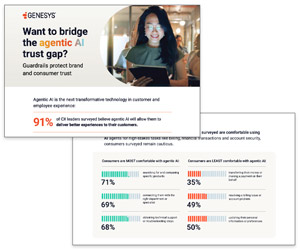David Porter at Genesys explains what resiliency means to today’s financial institutions – and their customers. He also explores modern day threats within the financial services industry and outlines how choosing the right solution can not only protect your customers and your business but can also improve satisfaction and loyalty.
Artificial intelligence (AI) is reshaping the financial services industry – offering powerful tools for automation, personalisation and a better client experience.
This means that many financial services companies are investing in secure, always-on, AI-powered customer services.
However, this upside does come with a downside: AI is also an effective enabler of modern fraud.
Today, anyone with a browser can create a fake identity or generate a cloned voice with alarming accuracy. The threat escalates when these deepfake capabilities are combined with snippets of real personal data, turning impersonation into a powerful tool for financial crime.
In this environment, it’s critical for financial institutions to focus on resiliency to balance the need to build competitive strength and maintain data security.
Financial Services Resiliency
Resiliency requirements have evolved from basic business continuity planning to comprehensive frameworks that demand proactive identification of vulnerabilities, rigorous testing and demonstrable ability to maintain critical services during disruptions.
The 2025 regulatory landscape, particularly in the UK, US and EU, represents a significant step change in expectations, with requirements now embedded in rulebooks rather than remaining as guidance.
Financial institutions that treat these requirements as strategic imperatives rather than compliance exercises will be better positioned to withstand operational shocks, maintain customer trust and can potentially gain a competitive advantage.
The key to success lies in moving beyond minimum compliance to building genuine resilience capabilities that protect not just the institution, but the customers and financial systems that depend on it.
As regulators increasingly view operational resilience as equally important to financial resiliency, banks must allocate appropriate resources and attention to meeting these critical requirements.
Also, operational resilience has become a critical priority for banks and financial institutions worldwide as they navigate an increasingly complex risk landscape marked by cyberthreats, technological disruptions and regulatory pressures.
Why Operational Resiliency Matters Today in Financial Services
Global regulators have elevated operational resilience to the same level of importance as financial resilience. These include:
- UK Operational Resilience Rules: Mandating identification of important business services, impact tolerance setting, and rigorous testing by March 2025.
- EU’s Digital Operational Resilience Act (DORA): Establishing strict ICT risk management and incident reporting requirements, effective as of January 2025.
- FFIEC Guidance: Introducing “maximum tolerable downtime” concepts in updated Business Continuity Management frameworks.
Financial services companies also face growing exposure to digital transformation risks and sophisticated cyberthreats that are difficult to identify and eliminate.
This is compounded by third-party risks, as companies increasingly rely on vendors for critical services. Financial IT reports that between January 2023 and February 2025, there were at least 158 banking IT failure incidents.
Finally, financial and reputational consequences are at stake due to a lack of operational resilience. This means increased financial volatility and instability, significant reputational damage when service disruptions occur and potentially undermining customer and stakeholder confidence.
Let’s look at some essential pieces for enabling your company to help maintain its resilience even when unplanned disruptions hit it.
5 Key Components of an Operational Resilience Framework
A structured approach to resilience should address risk across systems, people and partners – with continuous improvement and review.
1. Governance and Culture
Board and senior management must set the “tone at the top” and consider the entire operations ecosystem. This means fostering a culture of resilience throughout the organisation.
2. Critical Business Service Identification
Establish a repeatable process for identifying critical business functions and map interdependencies internally and externally, including third and fourth parties.
3. Impact Tolerance and Testing
Set realistic impact tolerances and recovery time objectives and conduct meaningful testing beyond tabletop exercises, using complex scenarios.
4. Third-Party Risk Management
Perform robust vendor risk assessments covering cyber, operational, and business continuity risks, then confirm critical third parties have adequate resilience measures.
5. Technology and Cybersecurity
Replace legacy systems with modern IT infrastructure and implement strong cyber-hygiene practices.
Responding to New Customer Behaviours
Based on actual and expected fraud losses from 2017 to 2027, Deloitte forecasts that generative AI could enable fraud losses to reach $40 billion in the US by 2027.
Fraud is big business, and it requires that financial services companies use a variety of tools for protection and resiliency.
Let’s translate this into customer impact. Think about how you call your bank today. The first thing many of us do is look for a 1-800 number on a statement or the back of a credit card.
Then, when you call the 800 number, you must go through the steps of phone verification. This time-consuming process is very typical.
More sophisticated financial services institutions offer better solutions within their apps, such as a help tab. Customers might choose in-app messaging, voice or a video call.
That escalation process is an app feature that makes it very simple for customers. Plus, within the app, it’s already a secured call — and there’s no need for extra verification.
This makes it tough for fraudsters to infiltrate; it also makes it better for clients and adds to the resiliency controls for a bank.
Outbound Finds a Second Life in AI Security
Finding a balance between fighting fraud and giving customers a positive experience is a complex challenge.
For example, customers do not want to be stopped at the point of sale at a supermarket or in a restaurant to be told that their card has been declined.
Yet, no one wants fraud, either. One is inconvenient and the other could have serious negative consequences.
To balance these realities, additional verification has become commonplace, often as a call to ensure that a cardholder is the legitimate card owner.
Emerging Threats and Solutions in the Financial Services Industry
We expect capabilities and uses for AI will continue to increase. This likely includes the secure integration of the communication mechanisms and vehicles at our disposal now, plus new areas we may not even know about yet.
AI will likely become even better at solving problems, but advancements may also be good news for fraudsters.
It’s possible they will have even more tools available to impersonate people and their lives, gain access to their data, compromise that data, and get control of their money.
For financial institutions, success depends, in part, on deploying AI within a framework built for resilience, flexibility and trust.
This blog post has been re-published by kind permission of Genesys – View the Original Article
For more information about Genesys - visit the Genesys Website
Call Centre Helper is not responsible for the content of these guest blog posts. The opinions expressed in this article are those of the author, and do not necessarily reflect those of Call Centre Helper.
Author: Genesys
Reviewed by: Jo Robinson
Published On: 21st Aug 2025 - Last modified: 22nd Aug 2025
Read more about - Guest Blogs, Genesys






 Genesys empowers more than 8,000 organisations in over 100 countries to improve loyalty and business outcomes by creating the best experiences for their customers and employees. Through Genesys Cloud, the AI-Powered Experience Orchestration platform, Genesys delivers the future of CX to organisations of all sizes so they can provide empathetic, personalised experience at scale. As the trusted platform that is born in the cloud, Genesys Cloud helps organisations accelerate growth by enabling them to differentiate with the right customer experience at the right time, while driving stronger workforce engagement, efficiency and operational improvements.
Genesys empowers more than 8,000 organisations in over 100 countries to improve loyalty and business outcomes by creating the best experiences for their customers and employees. Through Genesys Cloud, the AI-Powered Experience Orchestration platform, Genesys delivers the future of CX to organisations of all sizes so they can provide empathetic, personalised experience at scale. As the trusted platform that is born in the cloud, Genesys Cloud helps organisations accelerate growth by enabling them to differentiate with the right customer experience at the right time, while driving stronger workforce engagement, efficiency and operational improvements. 


































